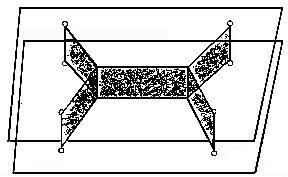It is remarkable how well natural systems can find minimal solutions to mathematical problems. Years ago I was shown, in a simple demonstration, an impressive example.
The problem was this: given several cities on a map, how can one lay out a minimal network of roads connecting them all?
To give a simple example, if there are three cities forming an equilateral triangle, the minimal solution is to find the point in the middle of the triangle, then build three roads from there, one to each city. But as more cites are added, the solution gets much more complicated, and when there are dozens or hundreds, finding an optimal solution (it’s called a Steiner tree, after mathematician Jakob Steiner) can be very time-consuming indeed (it belongs to a class of problems known as “NP-complete”).
As it happens, though, a simple contraption made of two sheets of plexiglass and a few nails, dipped into soapy water, does the trick in almost no time at all. The mathematical writer Ivars Peterson has a web-page that shows how it works, here. The result looks like this:

This is pretty impressive; the soap film acts as an analog computer that solves the problem very quickly indeed, in a non-algorithmic way.
What made me think of all this? Well, in today’s Times there was a brief item describing a slime mold‘s ability to do just this sort of thing. Experimenters laid out little piles of food in a Petri dish, and the slime mold quickly created a network of pathways joining them. To make the experiment moire interesting, the researchers organized the pattern of food-piles so as to represent the locations of cities near Tokyo, and the resulting network apparently bore a striking resemblance to the actual Tokyo-area rail system.
Read the story here.
2 Comments
Do you know of the book Emergence by Steven Johnson?
No, I hadn’t heard of it, but I’ll take a look.
This is a fascinating topic, and is of great importance for understanding what we are. If we naturalist types are going to have a coherent model of the world to set against theist and teleological paradigms, then we need to account for the emergence of intelligence and intentionality from mindless processes.
Thanks for the tip!